
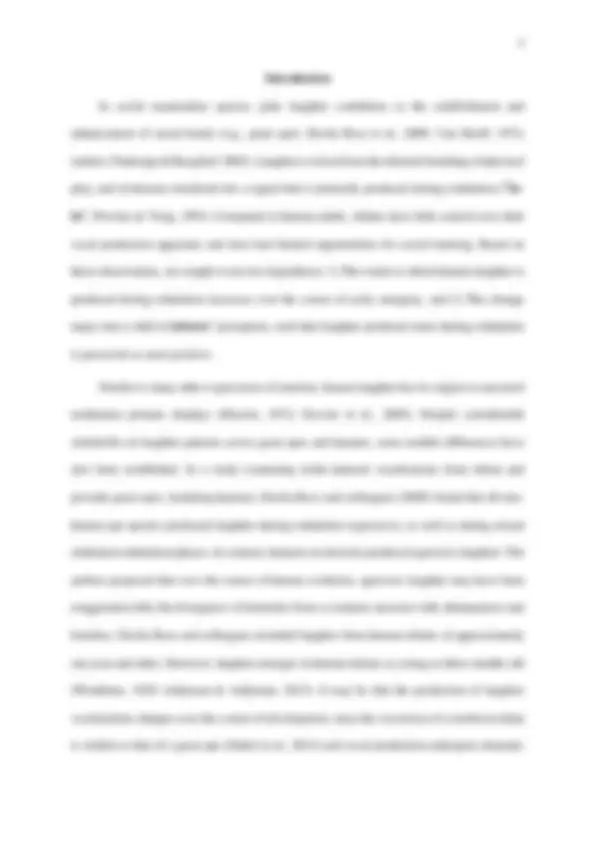
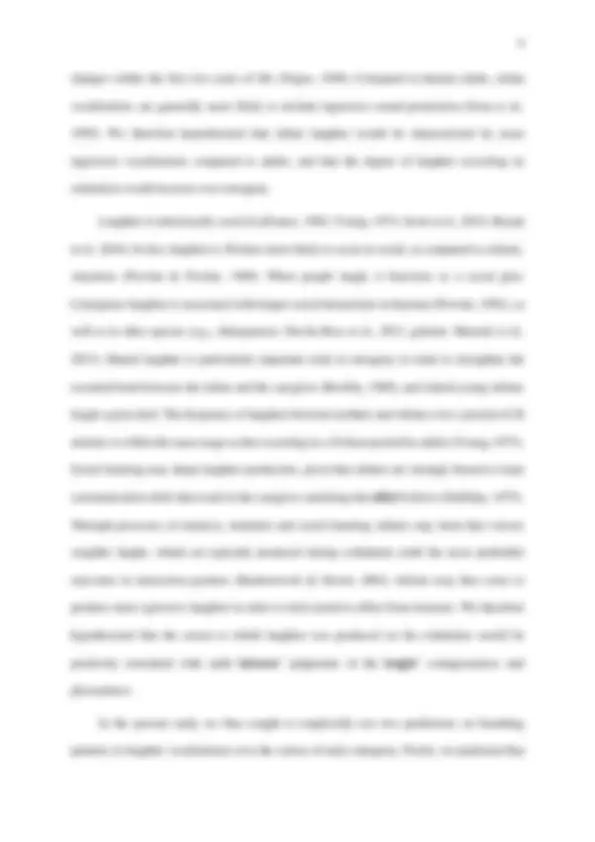
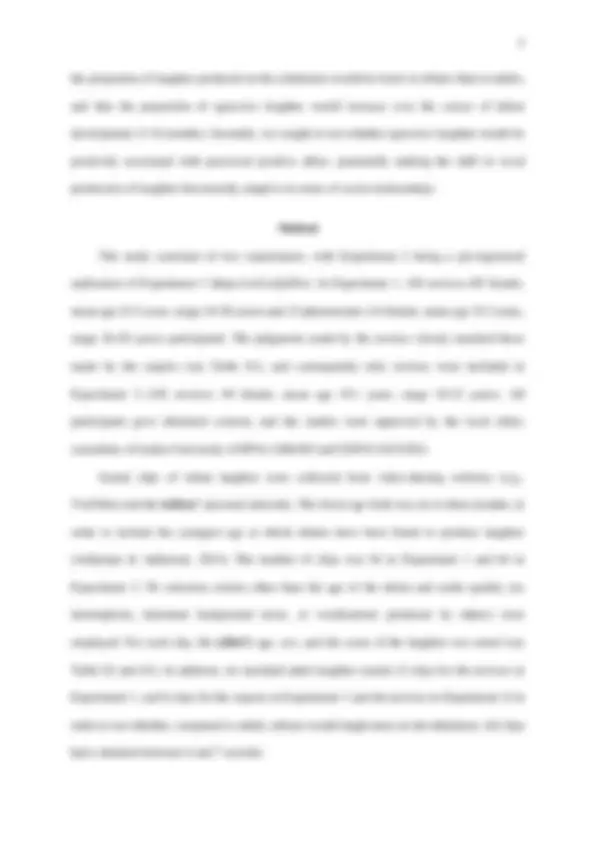
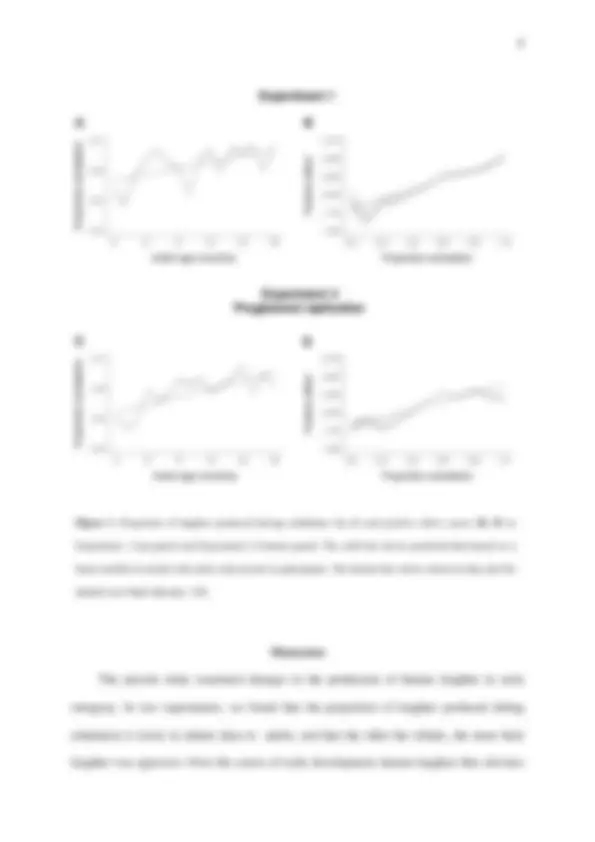
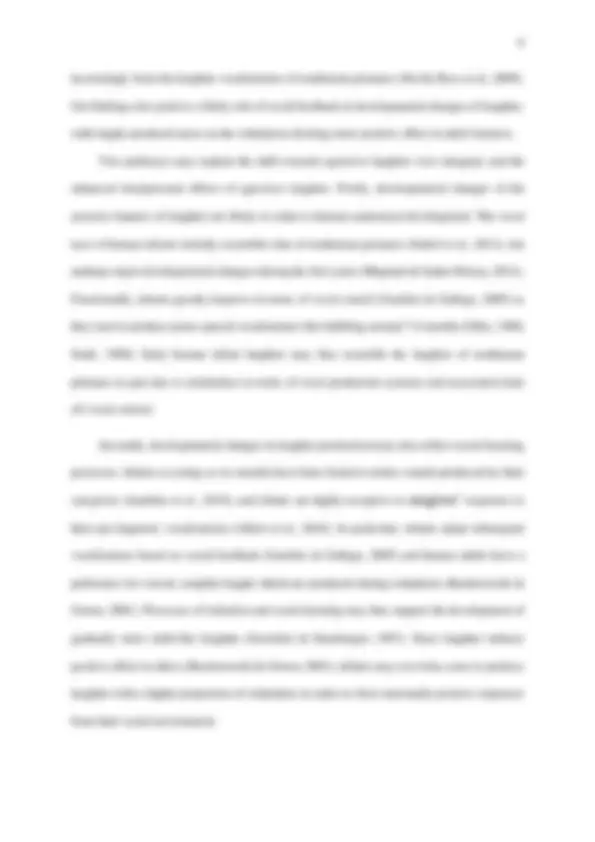
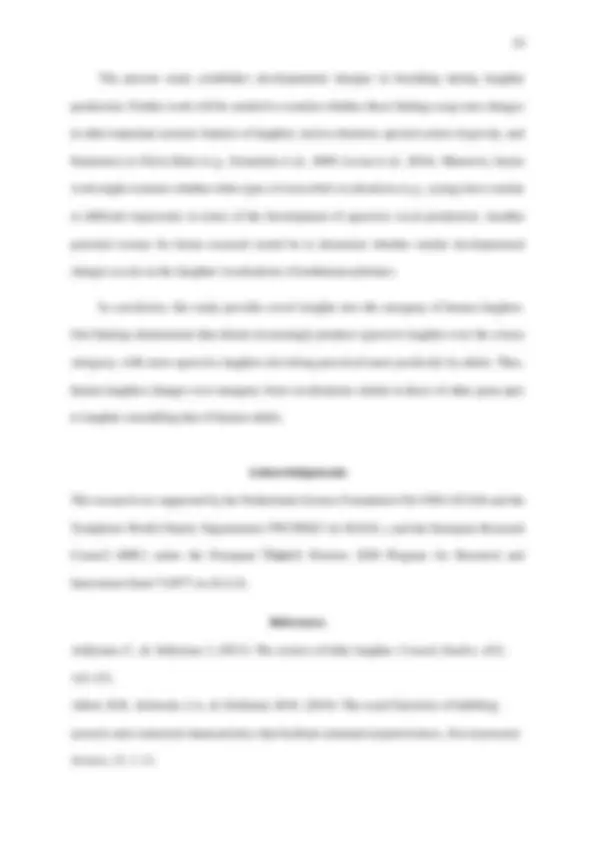

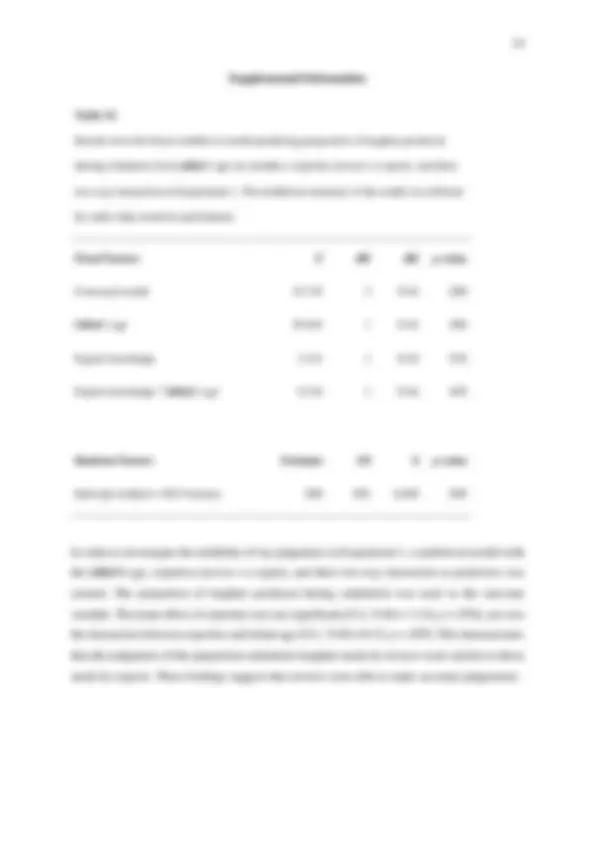
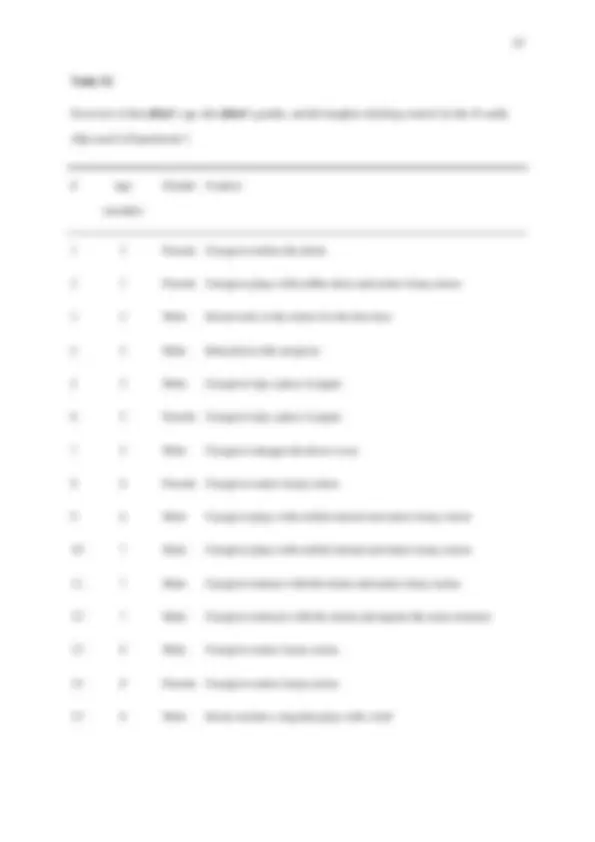
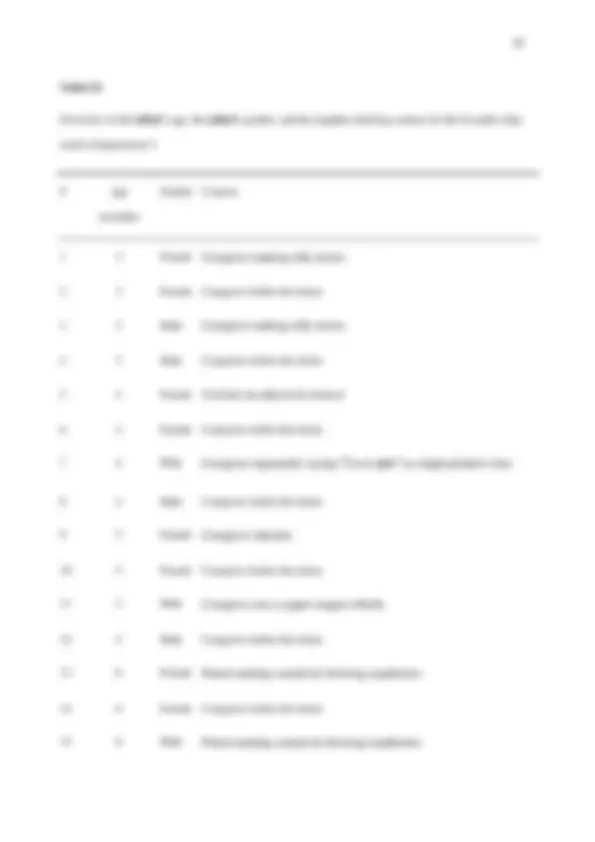
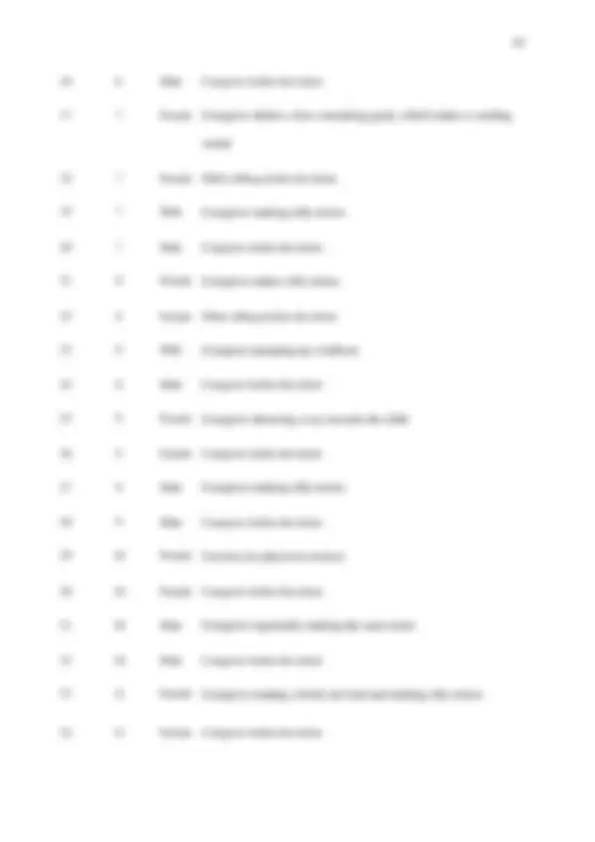
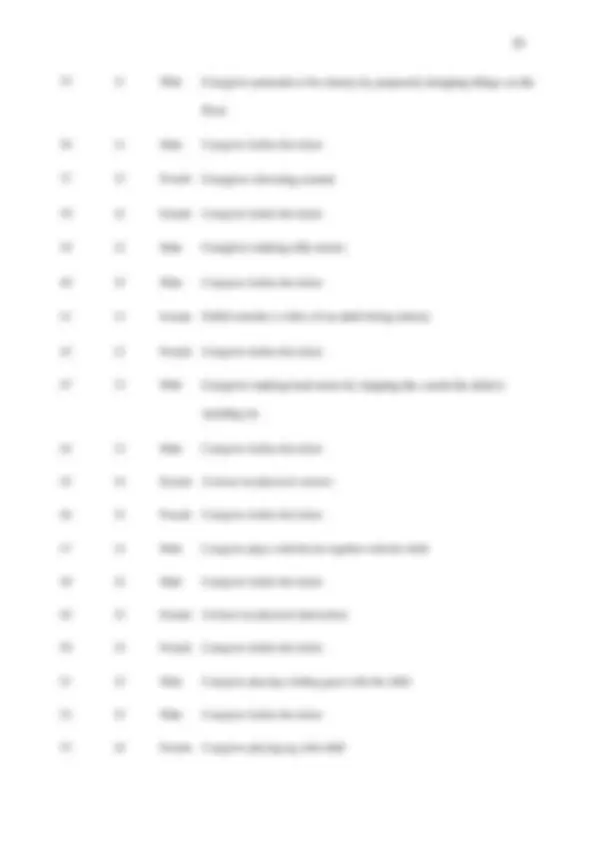
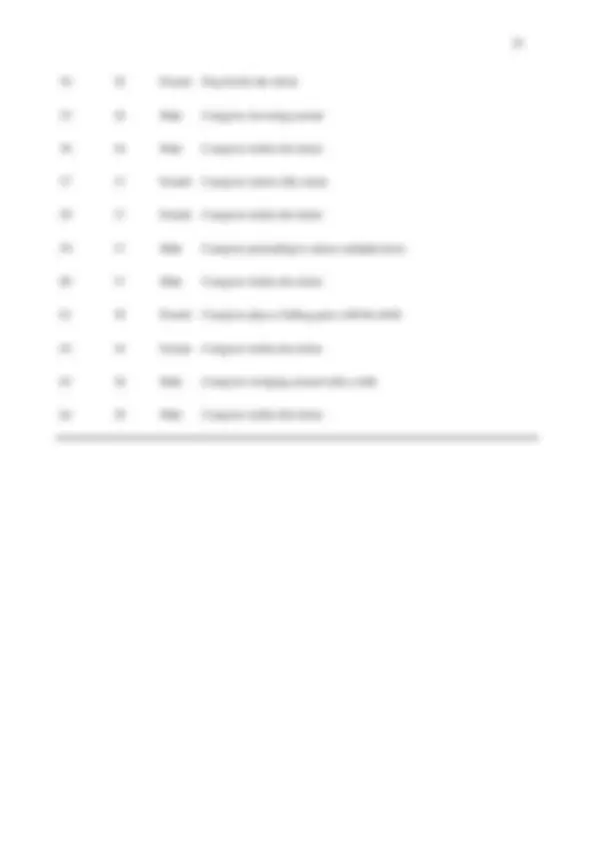
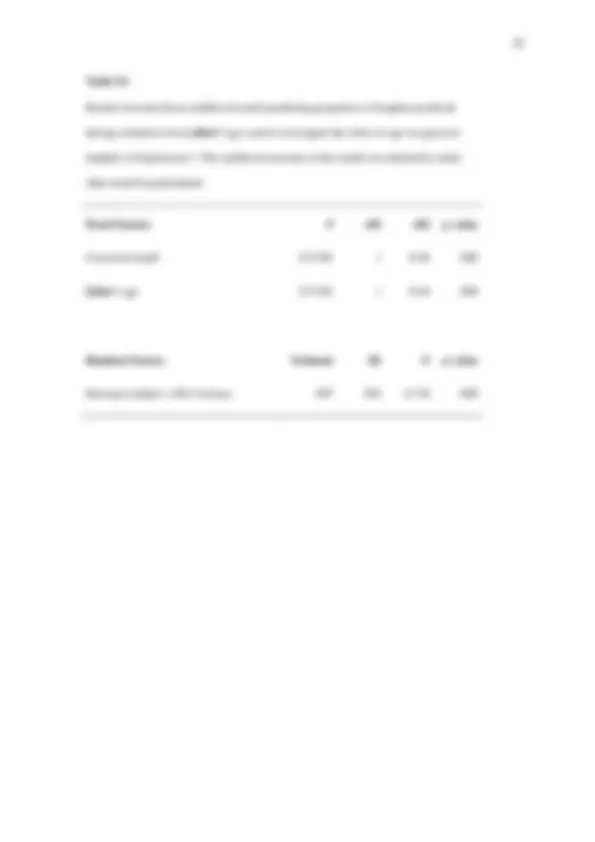
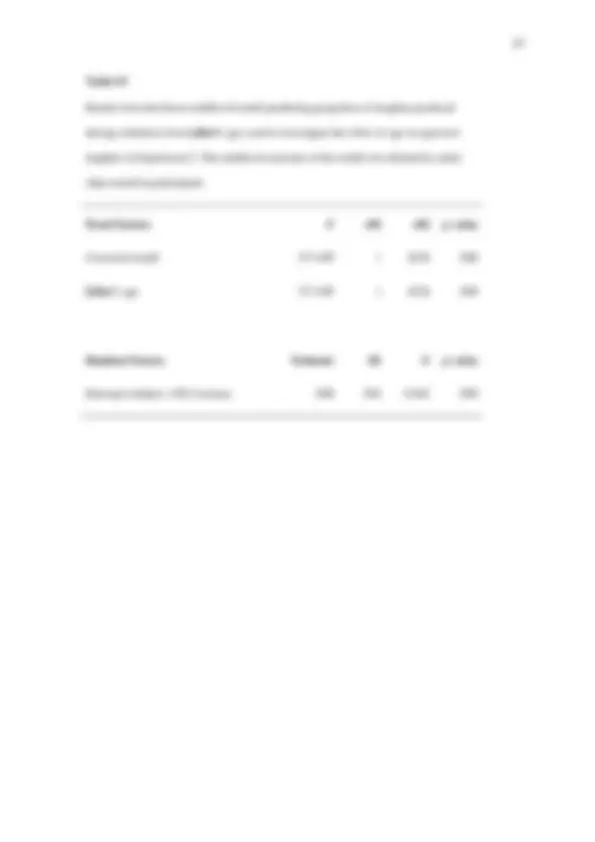
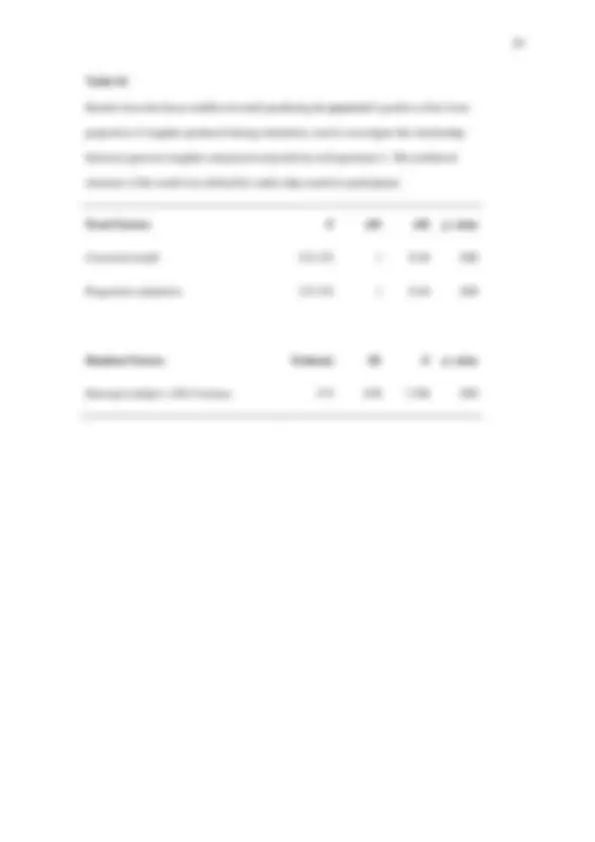
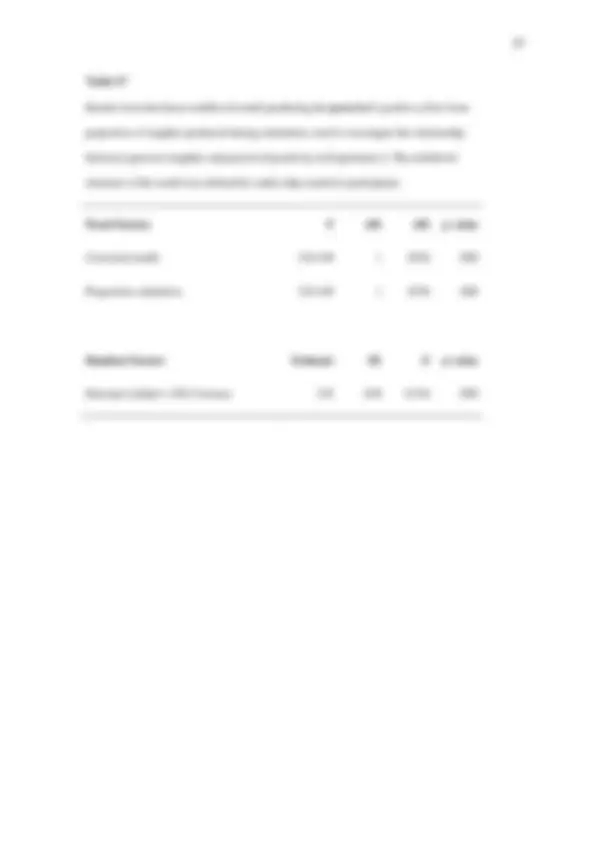


Study with the several resources on Docsity

Earn points by helping other students or get them with a premium plan


Prepare for your exams
Study with the several resources on Docsity

Earn points to download
Earn points by helping other students or get them with a premium plan
Community
Ask the community for help and clear up your study doubts
Discover the best universities in your country according to Docsity users
Free resources
Download our free guides on studying techniques, anxiety management strategies, and thesis advice from Docsity tutors
A study investigating the development of human laughter from infancy to adulthood. The research focuses on the hypothesis that human laughter changes from a production similar to non-human apes to resemble adult laughter. The study also explores the relationship between egressive laughter and perceived positivity. data from various age groups and gender contexts.
Typology: Summaries
1 / 25

This page cannot be seen from the preview
Don't miss anything!


















Mariska E. Kret 1,2*#, Dianne Venneker 1 #, Bronwen G. Evans 3 , & Disa A. Sauter 4 (^1) Department of Cognitive Psychology, Leiden University, 2333 AK Leiden, The Netherlands (^2) Leiden Institute for Brain and Cognition (LIBC), Leiden University, 2333 AK Leiden, The Netherlands (^3) Department of Phonetics and Linguistics, University College London, 4 Stephenson Way, London NW1 2HE, United Kingdom (^4) Department of Social Psychology, University of Amsterdam, 1018 WS Amsterdam, The Netherlands #These authors contributed equally. *Correspondence: m.e.kret@fsw.leidenuniv.nl
Summary During positive social interactions, humans and other great apes often laugh. Human adult laughter is characterized by vocal bursts produced predominantly during exhalation (“ha-ha- ha”). In contrast, apes laugh while exhaling and while inhaling. The current study tested the hypothesis that the laughter of human infants changes from laughter similar to that of non- human apes to increasingly resemble the laughter of human adults over the course of early development. Specifically, we hypothesized that infant laughter would be produced increasingly during exhalation over the course of ontogeny. Moreover, we predicted that, due to social learning processes, the more laughter was produced on the exhale, the more positively it would be perceived by adult listeners. To test these predictions, novice (n = 102) and expert (phonetician, n = 15) listeners judged the extent to which human infant laughter (n = 44 ) was produced during inhalation or exhalation, and the extent to which they found the laughs pleasant and contagious. As predicted, the proportion of laughter produced on the inhalation was higher in infants as compared to adults, and the proportion of laughter occurring on the exhalation increased with age. Consistent with our second hypothesis, the more laughter was produced on the exhalation, the more positively it was perceived by adult listeners. These results were confirmed in a pre-registered replication study with a new set of 64 audio clips and a new group of novice listeners (n = 102). These results demonstrate that, likely through a combination of social learning and the anatomical development of the vocal production system, human infants’ initial ape-like laughter transforms into laughter similar to that of adult humans over the course of early ontogeny. Keyword: laughter, vocalization, positive emotion, affect, ontogeny, evolution, primates
changes within the first two years of life (Negus, 1949). Compared to human adults, infant vocalizations are generally more likely to include ingressive sound production (Grau et al., 1995). We therefore hypothesized that infant laughter would be characterized by more ingressive vocalizations compared to adults, and that the degree of laughter occurring on exhalation would increase over ontogeny. Laughter is intrinsically social (LaFrance, 1983; Young, 1973; Scott et al., 2014; Bryant et al., 2016). In fact, laughter is 30 times more likely to occur in social, as compared to solitary, situations (Provine & Fischer, 1989). When people laugh, it functions as a social glue: Contagious laughter is associated with longer social interactions in humans (Provine, 1992), as well as in other species (e.g., chimpanzees: Davila-Ross et al., 2011; geladas: Mancini et al., 2013). Shared laughter is particularly important early in ontogeny in order to strengthen the essential bond between the infant and the caregiver (Bowlby, 1969), and indeed young infants laugh a great deal: The frequency of laughter between mothers and infants over a period of 20 minutes is within the same range as that occurring in a 24 - hour period for adults (Young, 1973). Social learning may shape laughter production, given that infants are strongly biased to learn communication skills that result in the caregiver satisfying the infant’s drives (Halliday, 1975). Through processes of mimicry, imitation and social learning, infants may learn that voiced, songlike laughs, which are typically produced during exhalation yield the most preferable outcomes in interaction partners (Bachorowski & Owren, 2001). Infants may thus come to produce more egressive laughter in order to elicit positive affect from listeners. We therefore hypothesized that the extent to which laughter was produced on the exhalation would be positively correlated with adult listeners’ judgments of the laughs’ contagiousness and pleasantness. In the present study we thus sought to empirically test two predictions on breathing patterns in laughter vocalizations over the course of early ontogeny. Firstly, we predicted that
the proportion of laughter produced on the exhalation would be lower in infants than in adults, and that the proportion of egressive laughter would increase over the course of infant development (3- 18 months). Secondly, we sought to test whether egressive laughter would be positively associated with perceived positive affect, potentially making the shift in vocal production of laughter functionally adaptive in terms of social relationships. Method The study consisted of two experiments, with Experiment 2 being a pre-registered replication of Experiment 1 (https://osf.io/j2d5w). In Experiment 1, 102 novices (89 female, mean age 23.5 years, range 18 - 58 years) and 15 phoneticians (14 female, mean age 35.3 years, range 26 - 58 years) participated. The judgments made by the novices closely matched those made by the experts (see Table S1), and consequently only novices were included in Experiment 2 (102 novices; 94 female, mean age 19.1 years, range 18 - 23 years). All participants gave informed consent, and the studies were approved by the local ethics committee of Leiden University (CEP16-1206/365 and CEP 19 - 1015/503). Sound clips of infant laughter were collected from video-sharing websites (e.g., YouTube) and the authors’ personal networks. The lower age limit was set to three months, in order to include the youngest age at which infants have been found to produce laughter (Addyman & Addyman, 2013). The number of clips was 44 in Experiment 1 and 64 in Experiment 2. No selection criteria other than the age of the infant and audio quality (no interruptions, dominant background noise, or vocalizations produced by others) were employed. For each clip, the infant’s age, sex, and the cause of the laughter was noted (see Table S2 and S3). In addition, we included adult laughter sounds (5 clips for the novices in Experiment 1, and 8 clips for the experts in Experiment 1 and the novices in Experiment 2) in order to test whether, compared to adults, infants would laugh more on the inhalation. All clips had a duration between 4 and 7 seconds.
experiment. Infant age was used as a predictor variable, and the proportion of laughter produced during exhalation as an outcome variable. As hypothesized, egressive laughter was found to increase with age (Experiment 1 F (1, 5146) = 123.98, p < .001, Table S4, Figure 1A; Experiment 2 F (1, 6526) = 337.4 9 , p < .001, Table S5, Figure 1C). Using linear multilevel models, we investigated whether the degree to which laughter was produced on the exhalation would predict the amount of positive affect evoked in adult perceivers. Proportion exhalation was used as a predictor variable and listener positive affect as an outcome variable. As hypothesized, the proportion of laughter produced on the exhalation positively predicted positive affect scores (Experiment 1 F (1, 5146) = 135.35, p < .001, Table S6, Figure 1B; Experiment 2 F (1, 6526) = 126.17, p < .001, Table S7, Figure 1D). Thus, the more the laughter was produced on the exhalation, the more positively it was perceived.
Discussion The present study examined changes in the production of human laughter in early ontogeny. In two experiments, we found that the proportion of laughter produced during exhalation is lower in infants than in adults, and that the older the infants, the more their laughter was egressive. Over the course of early development, human laughter thus deviates Experiment 1 Experiment 2 Pregistered replication Figure 1. Proportion of laughter produced during exhalation ( A, C ) and positive affect scores ( B, D ) in Experiment 1 (top panel) and Experiment 2 (bottom panel). The solid line shows predicted data based on a linear multilevel model with audio clips nested in participants. The dashed line shows observed data and the shaded error band indicates 1 SE.
The present study establishes developmental changes in breathing during laughter production. Further work will be needed to examine whether these findings map onto changes in other important acoustic features of laughter, such as duration, spectral center of gravity, and Harmonics-to-Noise-Ratio (e.g., Szameitat et al., 2009; Lavan et al., 2016). Moreover, future work might examine whether other types of nonverbal vocalizations (e.g., crying) have similar or different trajectories in terms of the development of egressive vocal production. Another potential avenue for future research would be to determine whether similar developmental changes occurs in the laughter vocalizations of nonhuman primates. In conclusion, this study provides novel insights into the ontogeny of human laughter. Our findings demonstrate that infants increasingly produce egressive laughter over the course ontogeny, with more egressive laughter also being perceived more positively by adults. Thus, human laughter changes over ontogeny from vocalizations similar to those of other great apes to laughter resembling that of human adults. Acknowledgements This research was supported by the Netherlands Science Foundation 016.VIDI.185.036 and the Templeton World Charity Organization TWCF0267 (to M.E.K.), and the European Research Council (ERC) under the European Union’s Horizon 2020 Program for Research and Innovation Grant 714977 (to D.A.S). References Addyman, C., & Addyman, I. (2013). The science of baby laughter. Comedy Studies, 4 (2), 143 - 153. Albert, R.R., Schwade, J.A., & Goldstein, M.H. (2018). The social functions of babbling: acoustic and contextual characteristics that facilitate maternal responsiveness. Developmental Science, 21 , 1 - 11.
Bachorowski, J. A., & Owren, M. J. (2001). Not all laughs are alike: Voiced but not unvoiced laughter readily elicits positive affect. Psychological Science, 12 (3), 252 - 257. Bowlby, J. (1969). Attachment (Vol. I). New York: Basic Books. Buckman, E. S. (Ed.). (1994). The handbook of humor: Clinical applications in psychotherapy. Malabar, Florida: Krieger. Bryant, G. A., Fessler, D. M., Fusaroli, R., Clint, E., Aarøe, L., Apicella, C. L., ... & De Smet, D. (2016). Detecting affiliation in colaughter across 24 societies. Proceedings of the National Academy of Sciences, 113 (17), 4682 - 4687. Clay, Z., Archbold, J., & Zuberbühler, K. (2015). Functional flexibility in wild bonobo vocal behaviour. PeerJ, 3 , e1124. Davila Ross, M., Owren, M. J., & Zimmermann, E. (2009). Reconstructing the evolution of laughter in great apes and humans. Current Biology, 19 (13), 1106 - 1111. Davila-Ross, M., Allcock, B., Thomas, C., & Bard, K. A. (2011). Aping expressions? Chimpanzees produce distinct laugh types when responding to laughter of others. Emotion 11 , 1013 - 1020. Gaultier, C., & Gallego, J. (2005). Development of respiratory control: Evolving concepts and perspectives. Respiratory Physiology & Neurobiology, 149 , 3 - 15. Gervais, M., & Wilson, D. S. (2005). The evolution and functions of laughter and humor: A synthetic approach. The Quarterly review of biology, 80 (4), 395 - 430. Halliday, M. (1975). Learning how to mean: explorations in the development of language. New York: Elsevier. Imafuku, M., Kanakogi, Y., Butler, D., & Myowa, M. (2019). Demystifying infant vocal imitation: The roles of mouth looking and speaker’s gaze. Developmental Science, 22 , 1 - 12.
Stabel, A., Kroeger-Geoppinger, K., McCullagh, J., Weiss, D., McCullagh, J., Schneider, N., Newman, D.B., Schultz-Krohn, W., Volkmar, F.R., Glennon, T.J., et al. (2013). Developmental Change. Encyclopedia of Autism Spectrum Disorders, 100 , 883 - 884. Stark, R.E.: Stage of speech development in the first year of life; in Yeni-Komshian, Kavanagh, Ferguson, Child phonology, vol. 1: Production (Academic Press, New York 1980) Stark, R.E., Bernstein, L.E., & Demorest, M.E. (1993). Vocal communication in the first 18 months of life. Journal of Speech, Language, and Hearing Research, 36 , 548 - 558. Szameitat, D.P., Alter, K., Szameitat, A.J., Wildgruber, D., Sterr, A., & Darwin, C.J. (2009). Acoustic profiles of distinct emotional expressions in laughter. The Journal of the Acoustical Society of America, 126 , 354 - 366. Todt, D., & Vettin, J. (2005). Human laughter, social play, and play vocalizations of non- human primates: An evolutionary approach. Behaviour, 142 (2), 217 - 240. Van Hooff, J. A. R. A. M. (1972). A comparative approach to the phylogeny of laughter and smiling. Non-verbal communication, 209 - 41. Vettin, J., & Todt, D. (2004). Laughter in conversation: Features of occurrence and acoustic structure. Journal of Nonverbal Behavior, 28 (2), 93 - 115. Washburn, R. W. (1929). A study of the smiling and laughing of infants in the first year of life. Genetic Psychology Monographs.
Supplemental Information Table S Results from the linear multilevel model predicting proportion of laughter produced during exhalation from infant’s age (in months), expertise (novice vs expert), and their two-way interaction in Experiment 1. The multilevel structure of the model was defined by audio clips nested in participants. Fixed Factors F df1 df2 p- value Corrected model 43.745 3 5144. Infant’s age 59.845 1 5144. Expert knowledge 3.151 1 5144. Expert knowledge * Infant’s age 0.154 1 5144. Random Factors Estimate SE Z p- value Intercept [subject = ID] Variance .006 .001 6.660. In order to investigate the reliability of lay judgments in Experiment 1, a multilevel model with the infant’s age, expertise (novice vs expert), and their two-way interaction as predictors was created. The proportion of laughter produced during exhalation was used as the outcome variable. The main effect of expertise was not significant [ F (1, 5144) = 3.16, p = .076], nor was the interaction between expertise and infant age [ F (1, 5144) =0.15, p = .695]. This demonstrates that the judgments of the proportion exhalation laughter made by novices were similar to those made by experts. These findings suggest that novices were able to make accurate judgements.
16 8 Male Caregiver rips a piece of paper 17 9 Male Caregiver repeatedly squeezes a toy that then makes a funny noise 18 9 Male Caregiver plays together with the infant 19 9 Female Caregiver scrapes paint of the window frame 20 9 Male Caregiver engages in social interaction with the infant 21 10 Male Caregiver tickles the infant 22 10 Male Baby sister crawls around 23 10 Male Ripping paper 24 11 Male Caregiver makes funny noises 25 11 Male Caregiver tickles the infant 26 11 Male Caregiver makes funny noises 27 12 Female Caregiver tickles the infant 28 12 Male Caregiver is making silly noises 29 12 Female Brother stumbles 30 13 Male Older sibling makes funny noises 31 13 Male Caregiver making silly noises 32 13 Male Caregiver engages in social interaction with the infant 33 14 Male Social interaction 34 14 Male Caregiver pretends to be clumsy by repeatedly dropping books on the floor 35 15 Male Caregiver tickles the infant
36 15 Male Infant watches a TV show for kids 37 15 Male Unknown 38 16 Female Caregiver tickles the infant 39 16 Male Uncle cheers when the infant scores while playing basketball 40 16 Female Caregiver engages in social interaction with the infant 41 17 Female Caregiver tickles the infant 42 17 Male Caregiver makes silly noises 43 18 Male Caregiver engages in social interaction with the infant and they play together 44 18 Female Caregiver tickles the infant Note : Three of the clips belong to the same infant (ID = 25); they were recorded at 8, 11, and 14 months of age.
16 6 Male Caregiver tickles the infant 17 7 Female Caregiver shakes a box containing grain, which makes a rustling sound 18 7 Female Older sibling tickles the infant 19 7 Male (^) Caregiver making silly noises 20 7 Male Caregiver tickles the infant 21 8 Female (^) Caregiver makes silly noises 22 8 Female Older sibling tickles the infant 23 8 Male (^) Caregiver pumping up a balloon 24 8 Male Caregiver tickles the infant 25 9 Female (^) Caregiver throwing a toy towards the child 26 9 Female Caregiver tickles the infant 27 9 Male Caregiver making silly noises 28 9 Male Caregiver tickles the infant 29 10 Female (^) Unclear (no physical contact) 30 10 Female Caregiver tickles the infant 31 10 Male (^) Caregiver repeatedly making the same noise 32 10 Male Caregiver tickles the infant 33 11 Female (^) Caregiver reading a book out loud and making silly noises 34 11 Female Caregiver tickles the infant
35 11 Male (^) Caregiver pretends to be clumsy by purposely dropping things on the floor 36 11 Male Caregiver tickles the infant 37 12 Female Caregiver clowning around 38 12 Female Caregiver tickles the infant 39 12 Male Caregiver making silly noises 40 12 Male Caregiver tickles the infant 41 13 Female Child watches a video of an adult being clumsy 42 13 Female Caregiver tickles the infant 43 13 Male (^) Caregiver making loud noise by slapping the couch the child is standing on 44 13 Male Caregiver tickles the infant 45 14 Female Unclear (no physical contact) 46 14 Female Caregiver tickles the infant 47 14 Male Caregiver plays with blocks together with the child 48 14 Male Caregiver tickles the infant 49 15 Female Unclear (no physical interaction) 50 15 Female Caregiver tickles the infant 51 15 Male Caregiver playing a hiding game with the child 52 15 Male Caregiver tickles the infant 53 16 Female Caregiver playing tag with child